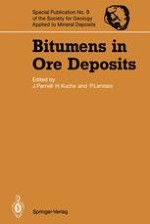1993 | Buch
Bitumens in Ore Deposits
herausgegeben von: Dr. John Parnell, Dr. Henryk Kucha, Dr. P. Landais
Verlag: Springer Berlin Heidelberg
Buchreihe : Special Publication of the Society for Geology Applied to Mineral Deposits
Enthalten in: Professional Book Archive
